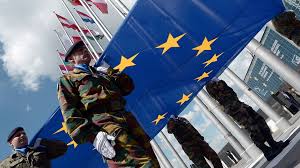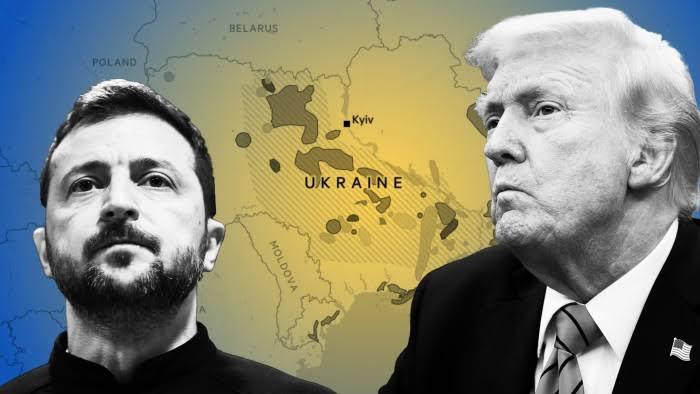
Zelenskyy: ‘President Trump is living in this disinformation space’
The evolving conflict between Russia and Ukraine—now entering its third year since Russia’s full-scale invasion in February 2022—has reached yet another tumultuous chapter. In recent days, statements and counter-statements have escalated tensions between world leaders. Most notably, Ukrainian President Volodymyr Zelenskyy publicly declared that US President Donald Trump is “living in this disinformation space.” This came after Trump appeared to blame Zelenskyy for failing to avert Russia’s invasion in 2022—an assertion widely contested by international experts and officials.
From Kyiv to Washington, from Riyadh to Moscow, diplomatic channels have been buzzing with fresh efforts to negotiate an end to the conflict. Yet these endeavours have been overshadowed by new disagreements on how peace might be achieved and which parties should be at the table. As the war grinds on, over eight million people have been displaced both internally and externally (according to the United Nations High Commissioner for Refugees, UNHCR), and more than 300,000 casualties have been estimated on both sides combined (per figures cited by Reuters and the Associated Press, though exact numbers remain difficult to verify).
This article delves into the multifaceted situation involving President Zelenskyy, Donald Trump, and Russian President Vladimir Putin, examining the core issues at stake, the motives of each actor, and the potential road ahead.
The Catalyst: Trump’s Controversial Remarks
The most recent dispute began with Donald Trump making a series of statements regarding the ongoing war in Ukraine. In a press briefing captured by several outlets—including DW News, Reuters, and The Associated Press—Trump remarked that Zelenskyy should have brokered a deal with Russia before the war escalated. Citing unverified claims, the US President suggested that Kyiv had “been there for three years” and “should have ended it” long ago.
The comments sparked widespread confusion among diplomats and foreign policy analysts. Critics argue that it glosses over the clear sequence of events: Russia unilaterally invaded Ukraine in February 2022, significantly violating Ukraine’s sovereignty. To many observers, Trump’s remarks appeared to sidestep the fact that Ukraine was the victim of aggression rather than the instigator of the conflict. Trump further implied that Zelenskyy’s leadership had been ineffective, referring to the Ukrainian President’s “4% approval ratings,” a figure disputed by Ukrainian and international polling agencies alike.
Zelenskyy’s Response: ‘Living in a Disinformation Space’
In a swiftly organised press conference in Kyiv, President Zelenskyy responded directly to Trump’s criticisms, stating that the US leader “lives in a disinformation space.” This language mirrors Zelenskyy’s belief that Russian propaganda has found echoes in global political discourse. Indeed, Ukrainian officials have accused Russian state media of spreading misleading narratives that attribute the war’s cause to Kyiv, NATO expansion, or Western interference.
Zelenskyy underscored that these narratives are part of a broader Kremlin tactic, aimed at eroding international support for Ukraine. He emphasised the factual timeline: Russia’s buildup of troops at Ukraine’s borders began in late 2021, culminating in the invasion of February 2022. It was not, Zelenskyy stressed, a conflict initiated by Kyiv. “We respect President Trump as a leader of a great nation,” Zelenskyy remarked, “but we must be clear that he has been influenced by what we see as Russian disinformation.”
Russia’s Role and Disinformation Campaigns
Accusations of Russian disinformation have been a cornerstone of Western discussions since the annexation of Crimea in 2014. According to investigations by the Atlantic Council and Bellingcat, Russia has employed state-controlled media outlets and social media networks to shape narratives abroad. These narratives commonly paint Ukraine’s government as aggressive and incompetent.
- State-Controlled Media: Channels such as Russia’s RT (formerly Russia Today) and Sputnik have consistently questioned Ukrainian sovereignty, framing Kyiv as the antagonist.
- Social Media: Pro-Russia Telegram channels and Twitter accounts have amplified stories—often false—that attribute blame for the conflict to Ukraine’s supposed NATO ambitions or alleged discrimination against Russian speakers.
- Political Influence: Several Western politicians have echoed, knowingly or otherwise, claims that align with Russia’s strategic objectives.
It is in this context that Zelenskyy’s remarks regarding Trump’s alleged acceptance of “false talking points” come to the fore. Many Ukrainian officials worry that by repeating elements of the Russian narrative, influential global leaders risk “normalising” or legitimising the aggression.
Diplomatic Maneuvers and Exclusion of Ukraine
Recently, the United States and Russia held a round of talks in Riyadh, Saudi Arabia. Much to Kyiv’s frustration, Ukraine was not invited to these discussions, prompting Zelenskyy to cancel what would have been a subsequent trip to the kingdom. Media outlets such as DW News reported that the Ukrainian leader felt sidetracked from negotiations that directly impacted his nation’s sovereignty and future.
- Talks in Saudi Arabia: Reports emerged that the US wanted to address certain security guarantees with Russia, potentially laying the groundwork for more comprehensive negotiations. However, excluding Ukraine from these discussions has heightened Ukrainian fears of being treated as an object—or bargaining chip—rather than a sovereign partner.
- US Envoy’s Visit: In an attempt to mitigate tensions, the US Special Envoy for Ukraine and Russia, Keith Kellogg, arrived in Kyiv shortly after the Riyadh meetings. Kellogg reassured Ukrainian officials of continued American support, stating, “We understand the need for security guarantees… sovereignty is a cornerstone of these discussions.”
- Putin’s Stance: While outwardly engaging in talks, President Putin has consistently sought direct negotiations with the United States, excluding Ukraine. In late 2021, the Kremlin demanded security assurances, including a ban on Ukrainian NATO membership—demands that were roundly rejected by Washington, Brussels, and Kyiv.
Observers from the European Council on Foreign Relations noted that Putin’s preference for direct discussions with the US reflects a broader strategy to diminish European and Ukrainian agencies in deciding the region’s future.
Ultimately, the human cost compels a renewed sense of urgency. The stories of families torn apart by shelling in Mariupol, the harrowing journeys of refugees fleeing Kharkiv, and the mounting mental and emotional toll on frontline soldiers remind us of the stakes. Millions of people yearn for a future free of conflict—where children can attend schools safely, homes are not threatened by missile strikes, and peace is more than a distant aspiration.
The View From Kyiv: Elections, Unity, and War
Another contentious issue is Trump’s call for Ukraine to hold elections despite being under martial law since the onset of the invasion. The Ukrainian constitution prohibits elections during a state of war, partly to ensure voting is free from coercion. Given the current security environment—with millions of Ukrainians internally displaced or living as refugees abroad—it is logistically implausible to organise fair elections.
President Zelenskyy and most opposition voices share a rare consensus on this point: elections under occupation risk producing illegitimate results and would embolden the aggressor. Ukrainian security expert Maria Afan, speaking with DW News, emphasised that any move toward elections at this juncture would only advance Russian strategic objectives, sowing discord in a nation that has thus far shown remarkable unity under duress.
European Allies and Broader International Response
As the conflict rages, European powers face mounting pressure to step up both diplomatic and material assistance. Many analysts argue that Europe must bolster its military aid and financial support to Ukraine, especially if the United States appears to waver under Trump’s rhetoric. France, Germany, and Poland have all reiterated their support for Ukraine’s territorial integrity, but have yet to announce a definitive roadmap for security guarantees.
Meanwhile, NATO member states have begun to consider alternative strategies:
- Rotational Troops: Some have proposed deploying limited peacekeeping forces from non-NATO nations, though Russia vehemently opposes any foreign “military presence” in Ukraine.
- Financial Aid: The European Union has pledged billions in macro-financial assistance, but the actual disbursement can be slow, and ongoing conflict threatens the viability of reconstruction efforts.
- Humanitarian Corridors: Discussions include expanding safe passage routes, and ensuring civilians in frontline regions receive critical aid. However, each side accuses the other of violating these corridors.
Potential Pathways to Peace
Despite the fraught atmosphere, diplomatic avenues remain open. Kyiv insists that any peace deal must include:
- Full Recognition of Ukraine’s Sovereignty: A restoration of Ukraine’s internationally recognised borders, as outlined before 2014, is a non-negotiable principle for many Ukrainian officials.
- Security Guarantees: Ukraine seeks binding agreements ensuring protection from future aggression. Suggestions range from explicit NATO-like security pledges to arms guarantees and international peacekeeping missions.
- Reconstruction Mechanisms: The World Bank estimates that rebuilding Ukraine could cost over USD 500 billion—a figure that balloons with each passing month of conflict. Any peace deal would likely encompass reparations and foreign investment assurances.
Moscow’s negotiating stance, however, has shown little inclination toward large-scale compromise. President Putin continues to demand recognition of the “new realities on the ground,” including territories currently occupied by Russian forces in Ukraine’s east and south.
Conclusion: Charting the Way Forward with Compassion and Resolve
The current impasse highlights one stark truth: Ukraine is more than an object of geopolitics. It is a nation of over 40 million people who have borne the brunt of a devastating conflict that shows few signs of abating. The disinformation swirling in global political discourse only heightens the sense of frustration in Kyiv, particularly when rhetoric downplays or misrepresents the origins of the war.
Although Zelenskyy has firmly rejected President Trump’s assertions, describing them as regurgitations of “Russian talking points,” the broader crisis of how to forge peace remains unresolved. Indeed, the conflict has spilt well beyond the realm of conventional warfare, turning into an information battle, a fight for national identity, and a contest of global influence.
In the face of ongoing aggression, Ukrainians continue to demonstrate resilience—a characteristic shaped by centuries of struggles for self-determination. European leaders and the United States have a profound decision to make: either uphold the fundamental principle that sovereign borders cannot be altered by force or risk a world that might make right. This is not just a Ukrainian predicament; it is a crossroads for the entire rules-based international order.
Ultimately, the human cost compels a renewed sense of urgency. The stories of families torn apart by shelling in Mariupol, the harrowing journeys of refugees fleeing Kharkiv, and the mounting mental and emotional toll on frontline soldiers remind us of the stakes. Millions of people yearn for a future free of conflict—where children can attend schools safely, homes are not threatened by missile strikes, and peace is more than a distant aspiration.
International observers, humanitarian organisations, and ordinary citizens worldwide look to their leaders for moral clarity and practical solutions. While high-level talks continue in capitals like Washington, Riyadh, and Brussels, Ukraine’s voice must remain central. Any meaningful resolution must be shaped by Ukrainians, for Ukrainians, and by those willing to champion democratic values.
Perhaps that is the most significant lesson of this moment. In an era of disinformation and short political memory, truth must prevail over expediency. Zelenskyy’s blunt critique of Trump stands as a reminder that misleading narratives—especially when adopted uncritically—can derail sincere peace efforts. Yet, with unwavering commitment, compassion, and the courage to tell uncomfortable truths, there remains hope that a just and lasting peace may soon dawn over Ukraine.
Aric Jabari is the Editorial Director at the Sixteenth Council



